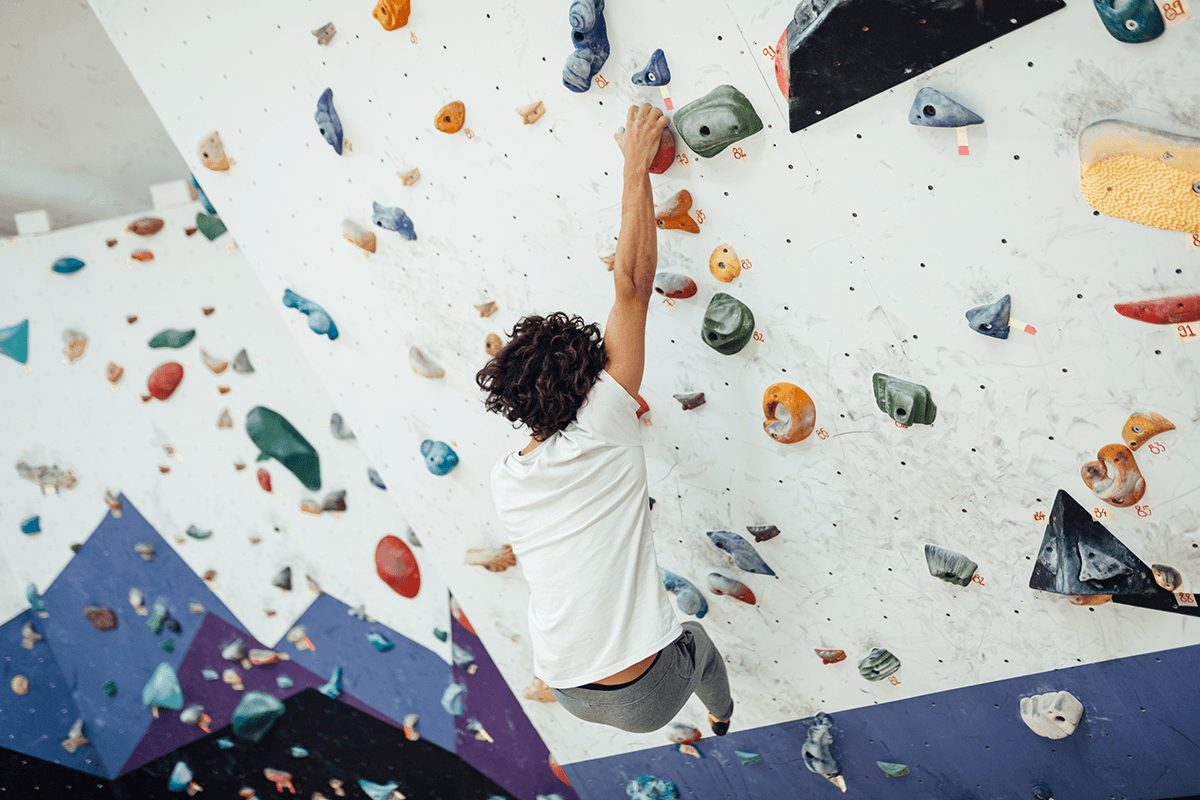Rock out your bouldering workout

A full-body workout, bouldering requires the use of many muscles in the body. Climbing enthusiast and assistant professor of family and community Medicine Dr. Mike Ren offers health tips for new and experienced climbers.
“I like bouldering because it tests and grows overall strength, endurance and flexibility,” Ren said. “The sport also requires problem-solving skills and precise movements, which improve body coordination and balance over time.”
Who should boulder?
People already physically active may enjoy the challenging nature of bouldering as it complements and enhances their existing fitness levels. Bouldering, which is primarily done indoors, targets various muscle groups and requires mental focus and strategy. It also can be a great auxiliary sport for athletes in other disciplines like gymnastics, martial arts or parkour, as it improves strength, flexibility and mental resilience.
Although there are benefits, some people might want to avoid bouldering. People with pre-existing or unresolved injuries, particularly in the shoulders, wrists or back, should avoid bouldering until they have fully healed. While bouldering may be done at lower heights, it still involves climbing, which might be intimidating or unsafe for those with severe vertigo. Older adults or people with limited mobility or joint issues may also find the sport too strenuous.
I’m ready to climb, how can I prepare?
Spend 10-15 minutes warming up with light cardio and dynamic stretching to increase blood flow to your muscles. Focus on stretching wrists, shoulders, hips and legs to optimize flexibility. Rotational stretches for the arms and wrists are particularly important. Finally, warm up your fingers with various grip exercises before mounting the wall during indoor bouldering to activate tendons in the forearms and hands.
While you’re on the wall, almost all parts of the body work together to keep you moving. The upper body uses forearms, biceps, triceps, shoulders, chest and upper back, especially the latissimus dorsi. Your core abdominal muscles, obliques and lower back muscles are heavily engaged to maintain balance and control, and your lower body muscles, such as your quads, hamstrings, calves and glutes are used to push off holds and stabilize the body.
Although bouldering is generally a safe sport, there is still some risk of injury. Finger pulley injuries occur when the tendons in the fingers are overstressed. Shoulder injuries like rotator cuff strains or dislocations can occur. If they happen, immediate rest, icing and seeking medical advice are essential. Finally, ankle sprains can occur, since bouldering involves frequent jumps or falls onto padded surfaces.
I’m worried about my hands while I’m on the wall. What can I do?
Skin peeling off the hands is not uncommon in climbing, so prevention and care is important. The skin on the hands peels due to the friction and pressure exerted on them while gripping rough holds. Repetitive stress can cause calluses, which eventually peel. Proper hand care begins with regularly filing down calluses to prevent them from catching and peeling. Moisturize your hands, but not too much before climbing. Special climbing tape can be applied to sensitive areas to reduce friction and pressure. Chalk is also commonly used to help keep the hands dry and reduce friction, but avoid over-chalking, which can dry out the skin excessively and lead to skin tearing.
These climbing shoes hurt, is that normal?
Shoes used for climbing and bouldering are designed for maximum traction and placement on the smallest climbing holds. This means the toe of the shoe is much narrower than normal shoes and may feel uncomfortable for first-time climbers. Ensure your shoes fit snugly but aren’t overly tight. They should be uncomfortable, not painful. To gradually break in the shoe, start by wearing bouldering shoes for short periods, gradually increasing the duration as your feet adapt. This helps avoid blisters and discomfort. Try walking around for a few minutes and put some weight on them.
To ensure good foot health, regularly stretch and strengthen your toes. Toe curls and picking up objects with your toes can help build the necessary strength and flexibility. After your climb, soak your feet in warm water with Epsom salt to soothe any soreness and reduce swelling. Lastly, keep your feet moisturized, especially around the toes, to prevent cracked skin.
If proper footcare is not followed, professional medical attention could be needed. If climbers experience ongoing pain or discomfort in the feet or toes that doesn’t improve with rest or aftercare, then a visit to a doctor may be required. Blisters, calluses or other skin conditions can become infected if not properly cleaned. Ingrown toenails, nail discoloration that doesn’t resolve and signs of deformity in the toes, such as hammer toes or bunions, are all causes of concern and should be examined with a podiatrist or primary care physician.
I’m off the wall, now what?
Cooling down from a climbing workout is as important as the warm-up. Engage in light stretching, particularly focusing on the forearms, shoulders and hips to reduce muscle soreness. Clean and moisturize your hands to prevent cracking and skin issues and apply a balm designed for climbers to keep the hands smooth and healthy. As with other sports, rehydration and eating a balanced meal or snack will aid with recovery.
Dr. Ren’s tips for new climbers
- Ensure you have adequate rest days between bouldering sessions to allow your muscles and tendons to recover.
- Start with easier climbs and gradually increase the difficulty as your strength and technique improve.
- Pay attention to any signs of pain or discomfort and avoid pushing through injuries.
“If you happen to catch me at the bouldering gym or outside at the crag, come say hi!” Ren said.
By Aaron Nieto



